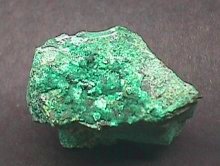The Mineral brochantite

Brochantite always occurs in an intensely deep green color. It is almost exclusively in groups of small radiating needles, and often found together with the similar mineral Cyanotrichite, which has a deep blue color. The combination of bright green Brochantite and bright blue Cyanotrichite creates a beautiful and contrasting specimen when found together.
Brochantite was named in honor of French
mineralogist and
geologist André-Jean-François-Marie Brochant de Villiers (1772-1840). Brochant de Villiers was a professor of geology and mineralogy in the École des Mines in France, as well as its first pupil.
Chemical Formula
CuSO4(OH)6
Color
Bright green to dark green
Crystal System
Monoclinic
Properties
Streak
Pale green |
Hardness
3.5 - 4 |
Transparency
Transparent to opaque |
Specific Gravity
4 |
Luster
Vitreous to silky |
Cleavage
1,1 - pinacoidal |
Fracture
Conchoidal, uneven, splintery |
Tenacity
Brittle |
Crystal Habits
Very rarely in visible crystals, which are prismatic and tabular. Most often acicular, radiating, earthy, grainy, encrusting, as fibrous masses, as dense bundles of acicular crystals, and as cotton-like, radiating masses. Sometimes as tiny twinned crystals that appear orthorhombic with rounded corners. Occasionally forms a pseudomorph after Azurite and Malachite, assume the crystal shape of those minerals.
Uses
Brochantite is a minor ore of copper.
Noteworthy Localities
Fine African localities of Brochantite include Katanga (Shaba), Congo (Zaire); Tsumeb, Namibia; and Goulmina, Mujuram, and Touissit, Morocco. Other Worldwide occurrences are Cloncurry, Mt Isa, Queensland, Australia; the Chengmenshan Mine, Jiurui, Jiangxi Province, China; and Copiapo and Chuquicamata, in the Atacama Desert, Chile. In Mexico, Brochantite comes from the Ojuela Mine, Mapimi, Durango; and a relatively new find of some of the finest examples of this mineral is the Milpillas Mine, Sonora.
Excellent Brochantite specimens have also come from many areas in the southwestern U.S. Arizona localities are Bisbee, Cochise Co.; Clifton and Morenci, Greenlee Co.; and the Grandview Mine, Concino Co. Other Southwest occurrences are Bingham, Socorro Co., New Mexico; the Douglas Hill Mine, Artesia Lake, Lyon Co., Nevada; the Tintic District, Juab Co., Utah; and the Green Monster mine, Independence, and Cerro Gordo, Inyo Co., California.
Distingushing Similar Minerals
Malachite - Effervesces in hydrochloric acid; otherwise practically indistinguishable from Brochantite.
Antlerite - Virtually indistinguishable from Brochantite without complex tests.
Dioptase - Crystals are not elongated like Brochantite.